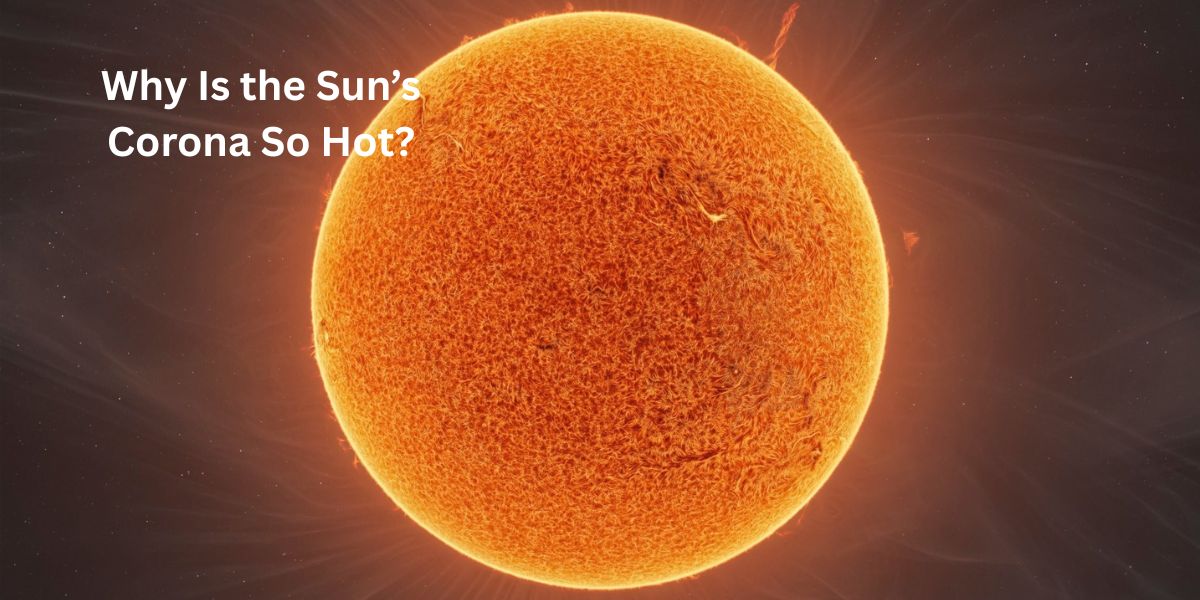Have you ever touched a light bulb after it’s been on for a while? It gets warm, right? Now, imagine something even hotter—the Sun’s corona. The corona is the Sun’s outer atmosphere, and it’s millions of degrees hotter than the Sun’s surface!
This is one of the biggest mysteries in space science. The Sun’s surface is about 5,500°C (10,000°F), but the corona reaches temperatures over 1 to 3 million degrees Celsius (2 to 5 million°F). How can the outer layer be so much hotter than the surface?
Scientists have been studying this for years, and they have some exciting theories. But first, let’s understand more about the Sun’s corona.
So, what makes the corona so incredibly hot?
What Is the Sun’s Corona?
The corona is the Sun’s outer atmosphere. It looks like a glowing white halo around the Sun during a total solar eclipse. Unlike the Sun’s bright surface, the corona is usually invisible because the Sun’s light outshines it.
Here are some cool facts about the corona:
- It extends millions of kilometers into space.
- It’s made of super-hot gas called plasma.
- It’s where solar winds come from—streams of charged particles that travel through space.
Even though the corona is far from the Sun’s core (where nuclear reactions happen), it’s much hotter than the surface. This is like standing near a campfire and feeling the air farther away hotter than the flames!
Why Is the Corona Hotter Than the Sun’s Surface?
This is the big question! Normally, you’d expect things to get cooler as you move away from a heat source. But the Sun breaks this rule. Scientists think a few things could be heating the corona:
Magnetic Fields Play a Big Role
The Sun has a powerful magnetic field. These magnetic lines twist, break, and reconnect, releasing huge amounts of energy—like snapping a rubber band. This energy heats the corona.
Tiny Solar Explosions (Nanoflares)
The Sun has constant small explosions called nanoflares. Even though each one is small, together they could heat the corona like thousands of tiny sparks lighting a fire.
Waves of Energy (Alfvén Waves)
Another theory is that magnetic waves travel from the Sun’s surface into the corona, carrying energy. These waves, called Alfvén waves, might transfer heat like ocean waves moving energy to the shore.
Scientists are still studying these ideas to find the best answer.
How Do Scientists Study the Sun’s Corona?
We can’t send a spacecraft into the Sun (it’s too hot!), but scientists use special tools to study the corona:
- Solar Telescopes: Like NASA’s Solar Dynamics Observatory (SDO), which takes high-quality images of the Sun.
- Space Probes: NASA’s Parker Solar Probe flies close to the Sun to study the corona.
- Eclipses: During a total solar eclipse, the Moon blocks the Sun’s bright surface, making the corona visible.
These tools help scientists measure temperature, magnetic fields, and solar activity.
What Happens If the Corona Gets Too Active?
The corona isn’t just hot—it’s also active. Sometimes, it releases solar flares (giant bursts of energy) and CMEs (Coronal Mass Ejections). These can affect Earth:
- Auroras: Charged particles create beautiful lights near the poles (Northern & Southern Lights).
- Satellite Damage: Strong solar storms can disrupt GPS and communication signals.
- Power Outages: In rare cases, they can even affect power grids.
Luckily, scientists monitor the Sun to predict these events.
Will We Ever Fully Understand the Corona?
Science is always improving! With new technology, we’re learning more every year. Missions like the Parker Solar Probe and ESA’s Solar Orbiter are helping solve the mystery.
One day, we might have a complete answer. Until then, the Sun’s corona remains one of space’s most fascinating puzzles!
What do you think heats the corona—magnetic fields, nanoflares, or something else?
📌 Frequently Asked Questions
Can we see the Sun’s corona every day?
No, the Sun’s bright surface usually hides the corona. We see it best during a total solar eclipse or with special telescopes.
How hot is the Sun’s corona compared to the surface?
The Sun’s surface is about 5,500°C, but the corona can reach 1 to 3 million°C—much hotter!
Does the corona affect Earth?
Yes! Solar winds and flares from the corona can create auroras and sometimes disrupt satellites.
Why is the corona only visible during an eclipse?
The Moon blocks the Sun’s bright surface, making the faint corona visible.
What is solar wind?
Solar wind is a stream of charged particles released from the corona, traveling through space.
How far does the corona extend?
The corona stretches millions of kilometers into space—far beyond the Sun’s visible surface.
What are coronal loops?
They are bright, curved lines of plasma in the corona, shaped by the Sun’s magnetic field.
Can the Sun’s corona harm astronauts?
Yes, strong solar radiation can be dangerous. Space missions monitor solar activity to keep astronauts safe.
What is space weather?
It refers to conditions in space affected by the Sun, like solar flares and storms.
Will the Sun’s corona ever cool down?
Not likely! The corona stays hot due to constant energy from the Sun’s magnetic activity.
